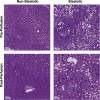Metabolic and lipidomic profiling of steatotic human livers during ex situ normothermic machine perfusion guides resuscitation strategies
- PMID: 31978172
- PMCID: PMC6980574
- DOI: 10.1371/journal.pone.0228011
Metabolic and lipidomic profiling of steatotic human livers during ex situ normothermic machine perfusion guides resuscitation strategies
Abstract
There continues to be a significant shortage of donor livers for transplantation. One impediment is the discard rate of fatty, or steatotic, livers because of their poor post-transplant function. Steatotic livers are prone to significant ischemia-reperfusion injury (IRI) and data regarding how best to improve the quality of steatotic livers is lacking. Herein, we use normothermic (37°C) machine perfusion in combination with metabolic and lipidomic profiling to elucidate deficiencies in metabolic pathways in steatotic livers, and to inform strategies for improving their function. During perfusion, energy cofactors increased in steatotic livers to a similar extent as non-steatotic livers, but there were significant deficits in anti-oxidant capacity, efficient energy utilization, and lipid metabolism. Steatotic livers appeared to oxidize fatty acids at a higher rate but favored ketone body production rather than energy regeneration via the tricyclic acid cycle. As a result, lactate clearance was slower and transaminase levels were higher in steatotic livers. Lipidomic profiling revealed ω-3 polyunsaturated fatty acids increased in non-steatotic livers to a greater extent than in steatotic livers. The novel use of metabolic and lipidomic profiling during ex situ normothermic machine perfusion has the potential to guide the resuscitation and rehabilitation of steatotic livers for transplantation.
Conflict of interest statement
Dr. Uygun is inventor on pending patents relevant to this study (WO/2011/002926; WO/2011/35223) and has a provisional patent application relevant to this study (MGH 22743). Dr. Uygun has a financial interest in Organ Solutions, a company focused on developing organ preservation technology. Dr. Uygun’s interests are managed by the MGH and Partners HealthCare in accordance with their conflict of interest policies. The hemoglobin-based oxygen carrier, Hemopure was kindly provided by HbO2 Therapeutics. This does not alter our adherence to PLOS ONE policies on sharing data and materials.
Figures









References
-
- United Network for Organ Sharing (UNOS). Available from: https://unos.org/data/transplant-trends/.
Publication types
MeSH terms
Substances
Grants and funding
LinkOut - more resources
Full Text Sources
Research Materials

